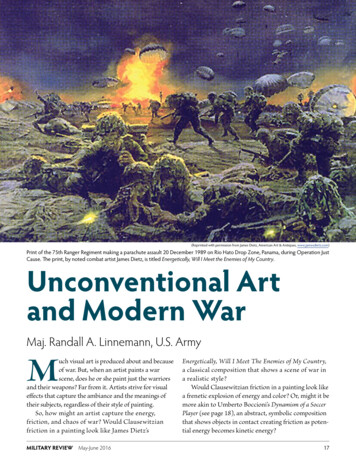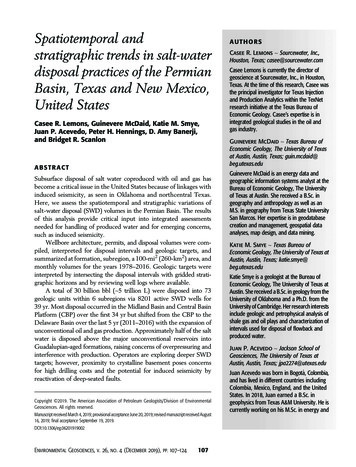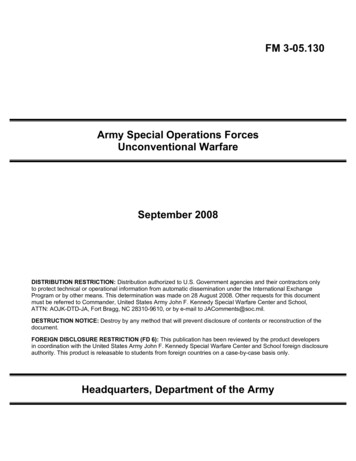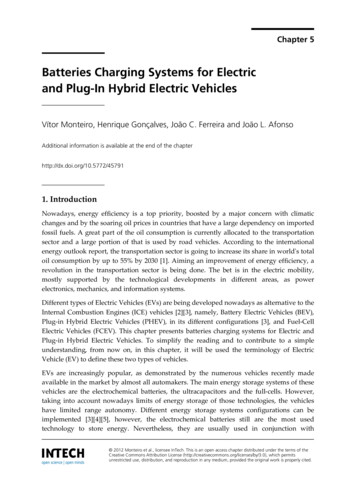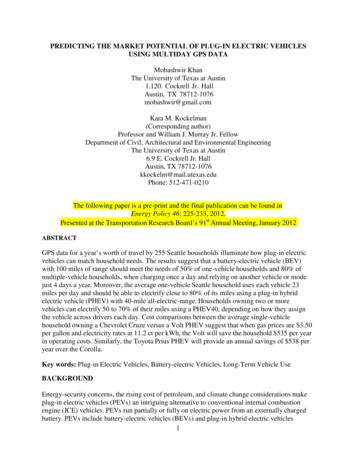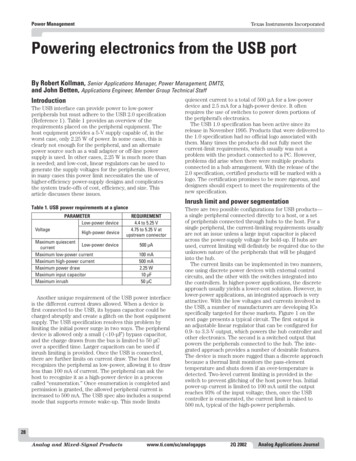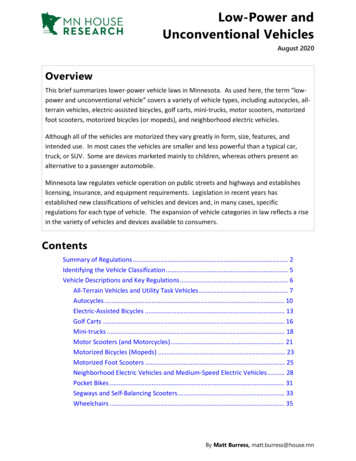
Transcription
Low-Power andUnconventional VehiclesAugust 2020OverviewThis brief summarizes lower-power vehicle laws in Minnesota. As used here, the term “lowpower and unconventional vehicle” covers a variety of vehicle types, including autocycles, allterrain vehicles, electric-assisted bicycles, golf carts, mini-trucks, motor scooters, motorizedfoot scooters, motorized bicycles (or mopeds), and neighborhood electric vehicles.Although all of the vehicles are motorized they vary greatly in form, size, features, andintended use. In most cases the vehicles are smaller and less powerful than a typical car,truck, or SUV. Some are devices marketed mainly to children, whereas others present analternative to a passenger automobile.Minnesota law regulates vehicle operation on public streets and highways and establisheslicensing, insurance, and equipment requirements. Legislation in recent years hasestablished new classifications of vehicles and devices and, in many cases, specificregulations for each type of vehicle. The expansion of vehicle categories in law reflects a risein the variety of vehicles and devices available to consumers.ContentsSummary of Regulations . 2Identifying the Vehicle Classification . 5Vehicle Descriptions and Key Regulations . 6All-Terrain Vehicles and Utility Task Vehicles . 7Autocycles . 10Electric-Assisted Bicycles . 13Golf Carts . 16Mini-trucks . 18Motor Scooters (and Motorcycles) . 21Motorized Bicycles (Mopeds) . 23Motorized Foot Scooters . 25Neighborhood Electric Vehicles and Medium-Speed Electric Vehicles . 28Pocket Bikes . 31Segways and Self-Balancing Scooters . 33Wheelchairs . 35By Matt Burress, matt.burress@house.mn
Low-Power and Unconventional VehiclesSummary of RegulationsThe tables below outline basic requirements for each type of vehicle. Subsequent sectionsprovide detail on the regulations.All-Terrain Vehicle andUtility Task VehicleAutocycleElectric-Assisted BicycleExampleLegalattributesATV: up to 960 cc engine,three to six flotation tires,max. 1,800 lbs. dry weightUTV: four wheels, up to1,200 cc engine, 1,800 to2,600 lbs. dry weightThree wheels,nonstraddled seats,steering wheel, anti-lockbrakes, meets federalsafety standards formotorcycleBicycle with saddle, pedalsfor human propulsion, twoto three wheels, max.1,000-watt electric motor,20 m.p.h. top speed, meetsfederal standardsRegistrationLocal special permit;typically DNR registrationfor ATV useTitle, vehicle registration,tax, license plateNot requiredOperatorlicensingNot requiredDriver’s license (noendorsement needed)None required; minimumoperator age is 15InsuranceLiability coverage (same aspassenger autos)Liability coverage (same aspassenger autos)Not requiredOperatingrulesGenerally same traffic lawsas other motor vehicles;some limitations onoperating at night and inlow visibilityGenerally same traffic lawsas other motor vehicles;various limitationsGenerally same traffic lawsas motor vehicles; variouslimitationsSafetyequipmentMost equipment laws donot apply; rearview mirrorHelmet if under age 18 andcabin is unenclosed;various equipmentrequirements; headlight onat all timesLighting generally requiredfor night; helmet notrequiredNotes“ATV” refers to an all-terrain vehicle.“UTV” refers to a utility task vehicle.“DNR” refers to the Department of Natural Resources.Minnesota House Research DepartmentPage 2
Low-Power and Unconventional VehiclesGolf CartMini-TruckMotor ScooterExampleLegalattributesNot specifically defined inlawUp to 660 cc or 7,500-wattengine, 900 to 2,200 lbs.dry weight, does not meetcertain federal safetystandardsNot specifically defined inlaw (but part of motorcycleclassification, whichincludes: seat or saddle, upto three wheels)RegistrationLocal special permitLocal special permit;possible DNR registrationas ATVTitle, vehicle registration,tax, license plateOperatorlicensingNot requiredDriver’s license or permitDriver’s license with twowheeled vehicleendorsementInsuranceLiability coverage (same aspassenger autos)Liability coverage (same aspassenger autos)Liability coverage (same aspassenger autos)OperatingrulesGenerally same traffic lawsas other motor vehicles;some limitations onoperating at night and inlow visibilityGenerally same traffic lawsas other motor vehiclesGenerally same traffic lawsas other motor vehicles;various limitations; nooperation on sidewalksSafetyequipmentMost equipment laws donot apply; rearview mirror;slow-moving vehicleemblemHeadlights; taillights; turnsignals; mirrors;windshield; seat belt;parking brakeHelmet if under age 18;various equipmentrequirements; eyeprotection for all operators;headlight on at all timesNotes“ATV” refers to an all-terrain vehicle.“DNR” refers to the Department of Natural Resources.Minnesota House Research DepartmentPage 3
Low-Power and Unconventional VehiclesMotorized FootScooterElectric VehicleHandlebars, motor,max. 12-inchwheels, 15 m.p.h.top speedNEV: electric motor,three to fourwheels, 20 to 25m.p.h. top speedMotorized BicycleSegway and SelfBalancing ScooterExampleLegalattributesUp to 50 cc and 2HP engine, 30m.p.h. top speedMSEV: electricmotor, misc.equipment, 35m.p.h. top speedElectric motor, twonontandem wheels,designed for oneperson, 15 m.p.h.top speedRegistrationTitle, vehicleregistration, tax,license plateNot requiredTitle, vehicleregistration, tax,license plateNot requiredOperatorlicensingDriver’s license oroperator’s permitNot required;minimum operatorage is 12Driver’s license orpermitNot requiredInsuranceLiability coverage(same as passengerautos)Not requiredLiability andpersonal injurycoverage (same aspassenger autos)Not requiredOperatingrulesGenerally sametraffic laws asmotorcycles andother motorvehicles; variouslimitations; nooperation onsidewalksGenerally sametraffic laws asbicycles; nooperation onsidewalks; allowedon certain bikepaths and trailsGenerally sametraffic laws as othermotor vehicles; nooperation on roadswith speed limitabove 35Generally sametraffic laws aspedestrians;allowed on bikepathsSafetyequipmentHelmet if under age18; eye protection;certain lightinggenerally requiredfor night; if soequipped, headlighton at all timesHelmet if under age18; headlight andreflector requiredfor nightMust meet federalequipmentrequirementsReflectors requiredNotes“NEV” refers to a neighborhood electric vehicle.“MSEV” refers to a medium-speed electric vehicle.Minnesota House Research DepartmentPage 4
Low-Power and Unconventional VehiclesIdentifying the Vehicle ClassificationDue to the wide variety of low-power and unconventional vehicles that are now on the market,it can be challenging to determine how a specific make and model in a particular year isclassified under Minnesota law. In particular, autocycles, motor scooters, motorized bicycles,and motorcycles have many similarities.Classifications. Because state regulation varies with each vehicle, a primary question iswhether the vehicle in question fits one of the legal definitions established in MinnesotaStatutes. See Minn. Stat. § 169.011. The specific characteristics of a particular vehicle can leadto its classification. Although other features are relevant, engine size is a key factor inidentifying scooters, mopeds, and motorcycles under Minnesota law. Top speed, vehicleweight, and safety equipment are also important characteristics.A vehicle that has two or three wheels and does not clearly fit another vehicle definition is mostlikely classified in law as a “motorcycle” (even though it might not be considered one in thetraditional sense). This is the most general class of motorized vehicle that has less than fourwheels. As discussed below, requirements for a vehicle classified as a motorcycle include atitle, registration, and license plates.The broad categorization for a vehicle or device that does not conform to any specificmotorized vehicle definition is likely a “motor vehicle.” As such, it would need to be registeredand have license plates, the operator must have a driver’s license, it must have full insurancecoverage, and the vehicle must have safety equipment that includes lights, turn signals, andbrakes at both the front and rear.Making determinations. Several governmental entities are resources for questions and couldpotentially become involved in making a determination about a specific vehicle. The tablebelow provides a general summary.Governmental EntityRoleDeputy registrarOffices for vehicle registration, titling, andregistration tax collectionDriver and Vehicle Services(Department of Public Safety)Vehicle registration and titling – final decisions;Registration tax administrationLaw enforcement agency (e.g.,municipal police department)Enforcement of regulations;CitationsCourtsJudicial (e.g., contested citation)Minnesota House Research DepartmentPage 5
Low-Power and Unconventional VehiclesVehicle Descriptions and Key RegulationsMotorized vehicles face limited state regulation while operated on private land. Once theyventure onto streets, roads, and even alleys they are subject to a wider array of state and localregulations. In response to the introduction of new models and offerings in the marketplace,recent changes in Minnesota law have addressed many of the assorted vehicles that can beoperated on public roadways.The following sections cover each vehicle type classified under Minnesota law, outlining theirlegal definitions and general characteristics, highlighting some recent law changes, providing anoverview of notable regulatory provisions, and noting some laws in other states.A variety of regulations apply generally to motorized vehicles and are not specifically addressedin provisions that govern a specific low-power or unconventional vehicle. A couple of examplesare below.1 Driving rules. Most driving regulations such as speed limits and rules of the road areapplicable when operating low-power and unconventional vehicles. Some operatingrules are established for specific vehicles. (Licensing, registration, operation, andequipment are discussed with each vehicle in the following sections.) DWI/DUI laws. Prohibitions on operating under the influence of alcohol and otherdrugs extend to a number of low-power and unconventional vehicles. However,courts have found that impaired driving restrictions do not apply to some devicesthat are not designed to operate on roads, such as Segways and motorizedwheelchairs. 1 Noise limits. Minnesota law sets noise limits for motor vehicles (separately forheavier trucks, motorcycles, and other types of vehicles). Minn. Stat. § 169.693;Minn. Rules ch. 7030. The limits apply based on whether the vehicle must beregistered to operate on public roads, and registration is not required for some ofthe vehicles described in this briefing. Most motor vehicles are also required tohave a muffler meeting various characteristics. Minn. Stat. § 169.69.See State v. Brown, 801 N.W.2d 186 (Minn. App. 2011); State v. Greenman, 825 N.W.2d 387 (Minn. App. 2013).Minnesota House Research DepartmentPage 6
Low-Power and Unconventional VehiclesAll-Terrain Vehicles and Utility Task VehiclesClassification 2All-terrain vehicles. All-terrain vehicles (ATVs) under Minnesotalaw are motorized vehicles having three to six tires, a dry weight ofup to 2,000 pounds, and a total width of up to 65 inches. Seating isnot specifically identified under the statutory definition; ATVdesigns include a seat or a saddle so that the operator (and anypassenger) sits straddling the vehicle. ATVs are further categorizedbased on width into class 1 (total width of 50 inches or less) andclass 2 (from over 50 to 65 inches in width). They are often usedfor off-road recreation on trails or private land. Minn. Stat. § 84.92,subds. 8 to 10; 169.045, subd. 1.Utility task vehicles. To be considered a utility task vehicle (UTV)in Minnesota law, the vehicle must have four wheels, four-wheeldrive, an internal combustion engine with a displacement of nomore than 1,200 cc, and a dry weight of 1,800 to 2,600 pounds.Also known as a “side-by-side” (among other terms), a UTV hasside-by-side seating, in some cases carries multiple passengers ina cab-like space, and often includes an open bed located behindthe driver and passengers (like a pickup truck). The vehicle issimilar to an ATV in its off-road purposes although with anarguably greater capability for nonrecreational activities. Minn.Stat. § 169.045, subd. 1.RegulationsUnlike most motor vehicles using public roads, ATVs and UTVs are not titled or registered withthe Department of Public Safety. Permissible operation on public roads is limited. ATVs andUTVs can be operated on public roads and in some public rights-of-way under two distinct setsof state statutes governing the vehicles.1) Operation on local roads can be by special permit. The permit is issued by a localunit of government (a city, county, or town) following a local ordinance that mustmeet requirements set in state statute, and it only authorizes driving on particularroads under the jurisdiction of the issuing authority. This is a discretionary programthat each local government may choose to set up, so ATV and UTV operation isessentially prevented if a local government has not taken the steps of establishingthe ordinance and issuing special permits. Minn. Stat. § 169.045.2Image sources: http://www.gekgo.com/cpi-gas-atvs.html; Minnesota House Research DepartmentPage 7
Low-Power and Unconventional Vehicles2) ATVs and other types of off-road vehicles are subject to various off-highway vehicleregulations set in state law and primarily administered by the Department ofNatural Resources. They can operate on some parts of public rights-of-way (that is,on the roadway itself, the road shoulder, the inside bank or slope, the ditch, and theoutside bank or slope) and on bridges under some circumstances. Allowedoperation depends on several factors: the type of road (trunk highway, countyhighway, town road, or city street), the type of ATV (class 1 versus class 2), and timeof year for some regions of the state. Minn. Stat. §§ 84.92 to 84.928.While ATVs are not registered for on-road use in the same manner as passenger vehicles, inmany cases they must be registered with the Department of Natural Resources for use ondesignated trails, public lands, and other off-road locations. ATVs and riders are also subject tovarious regulations that include: display of registration information, where the vehicle can beridden, operating rules, passenger restrictions, required vehicle equipment, and otherlimitations for youth operators. (General off-highway vehicle and ATV regulations, underMinnesota Statutes, chapter 84, are not discussed further in this publication.)Requirements Under the Special PermitRegistration. The vehicles are not registered with the Department of Public Safety inthe manner of other motor vehicles and do not require titling or license plates. (Inmany cases, ATV or UTV registration is required under off-highway vehicle regulations.)Operation of ATVs and UTVs can be allowed via a special permit issued to the vehicleowner by counties, cities, or towns. Minn. Stat. § 169.045, subd. 1. The MinnesotaDepartment of Transportation cannot issue the permit for use on trunk highways(including the interstate system).A key requirement is that the governing body must establish a special permit ordinance,and the ordinance must provide for permit application and confirmation that insurancerequirements are met. The ordinance can also set additional conditions and requirecertification by a physician of ability to safely operate the vehicle. The permit can limituse to certain roads and must be renewed at least every three years, as determined bythe unit of government. It can be revoked at any time based on evidence of inability tosafely operate the vehicle.Operator licensing. By statute, a person is not required to have a driver’s license orinstruction permit to operate the vehicle under a special permit. Minn. Stat. § 169.045,subd. 7. (However, a driver’s license may be required for operating on public roadrights-of-way under off-highway vehicle regulations.)Insurance. Insurance requirements must be established as part of the local ordinanceand must match that of motorcycles. Thus liability insurance (which covers certainMinnesota House Research DepartmentPage 8
Low-Power and Unconventional Vehiclesclaims from another driver) is required and is the same as for passenger automobiles.3However, the vehicles are exempt from the requirements of personal injury protectionunder the Minnesota No-Fault Automobile Insurance Act (which establishes minimumrequired coverage levels for medical, lost wages, and related expenses). Minn. Stat.§§ 65B.48, subd. 5; 169.045, subd. 2.If insurance cannot be obtained on the private market, it can be purchased from theMinnesota Automobile Insurance Plan with a rate determined by the Departmentof Commerce. Minn. Stat. § 169.045, subd. 8.Use. Vehicle operation under a special permit is only allowed on roadways under thejurisdiction of the issuing unit of government. A city-issued permit, for instance, doesnot authorize driving on county roads; a separate permit would be required. (The law issilent on coordination between local units of government for permit issuance andapplicability.)Drivers of ATVs and UTVs are subject to the same traffic laws and duties as operators ofother motor vehicles, although additional limitations apply. The vehicles can only beoperated on designated roadways, but they may cross other roads and highways. Thevehicles can only be operated between sunrise and sunset unless original equipmentincludes headlights, taillights, and brake lights. They cannot be used (1) in bad weatherunless the authorizing ordinance provides an exception for emergencies, or (2) if thereis not enough visibility to see people and other vehicles from 500 feet away. Minn.Stat. § 169.045, subds. 3, 5, 6.Safety equipment. Standard equipment requirements for motor vehicles do not applyto vehicles operating under the special permit, except that a rearview mirror isnecessary. The mirror must provide a view to the rear for at least 200 feet. Minn. Stat.§ 169.045, subd. 7.3The minimum liability coverage is 30,000 per person for injuries, 60,000 per occurrence for injuries, and 10,000 for property damage.Minnesota House Research DepartmentPage 9
Low-Power and Unconventional VehiclesAutocyclesClassification 4Autocycles represent a specialized type of motorcycle that,generally speaking, resemble a car. To meet the classification,the vehicle must have three wheels, driver and passengerseating (as opposed to a saddle that is straddled), a steeringwheel, and antilock brakes. It must also meet federal safetystandards established for motorcycles (there is not a separatefederal autocycle classification for vehicle manufacturers).Minn. Stat. § 169.011, subd. 3a.The statutory definition does not specify a configuration for the three wheels, so two wheelscould be located in either the front or the back. Similarly there are no restrictions regarding thenumber of passengers, seating positions, cabin enclosure (versus an open air cockpit), hingeddoors, and availability of seatbelts.The autocycle category reflects some of the offerings to most recently enter the automotivemarket. Some new models increasingly blur the traditional distinctions between a motorcycleand a passenger vehicle, such as by providing car-like driving dynamics without the same crashprotections available in passenger autos (which must meet various federal safety standards thatare more extensive compared to ones for motorcycles).RegulationsRegistration. Like other motorcycles, the owner of an autocycle must register it, andthe vehicle is subject to a registration tax of 10. Minn. Stat. § 168.013, subd. 1b. Thelicense plate must be displayed on the rear of the vehicle. Minn. Stat. § 169.79, subd.3. A certificate of title also must be obtained. The vehicle is subject to the motorvehicle sales tax. Minn. Stat. §§ 297B.01, subd. 11; 297B.02.Operator licensing. Required licensing differs from a standard motorcycle in that a twowheeled vehicle endorsement is not necessary. Instead an autocycle can be operatedwith a standard driver’s license.Insurance. Liability insurance (which covers certain claims from another driver) isrequired and is the same as for passenger automobiles. 5 Like motorcycles generally,autocycles are exempt from the requirements of personal injury protection under theMinnesota No-Fault Automobile Insurance Act (which establishes minimum required4Image source: Polaris, http://www.polaris.com.5The minimum liability coverage is 30,000 per person for injuries, 60,000 per occurrence for injuries, and 10,000 for property damage. Note that the insurance requirements do not appear to apply to all motorcyclesand motor scooters: under the definition of “motorcycle” in the chapter on automobile insurance, thevehicle’s engine must be “rated at greater than five horsepower.” Minn. Stat. § 65B.43, subd. 13.Minnesota House Research DepartmentPage 10
Low-Power and Unconventional Vehiclescoverage levels for medical, lost wages, and related expenses). Minn. Stat. §§ 65B.43,subds. 2, 13; 65B.48, subd. 5.Use. Autocycle operators are subject to the same traffic laws as operators of othermotor vehicles (except those that by their nature would not be relevant). The vehiclescan potentially be operated two abreast, although they must be narrow enough to fitwithin a single traffic lane. Passengers are allowed based on the vehicle’s seatingcapacity.Some prohibitions also apply, such as on carrying cargo that prevents operation withboth hands, passing other vehicles by going between traffic lanes, and passingvehicles that occupy the same lane as the autocycle. Minn. Stat. § 169.974, subd. 5.Safety equipment. The vehicle must be equipped with various safety features, includingat least one rearview mirror, a horn, a hand or foot brake, at least one headlight thathas both low and high beams and is lighted at all times, a taillight, a brake light, rearlicense plate illumination, and floorboards (or footrests) for any passenger seating.Minn. Stat. §§ 169.49; 169.50; 169.57, subd. 1; 169.60; 169.67, subd. 2; 169.974, subd. 3and subd. 5(i).A seatbelt must be worn if the autocycle is equipped with it. Minn. Stat. §169.686, subd. 1.Unless the autocycle has an enclosed cab, a helmet is required for operators andpassengers under the age of 18 and eye protection is required for all operators.Minn. Stat. § 169.974, subd. 4.Other StatesThe introduction of autocycles into the marketplace has prompted state legislative responses inrecent years. One federal report identifies 38 states that have established an autocycleclassification.6 States define autocycles in a wide variety of ways, which is perhaps due to thelack of a corresponding federal classification. According to a 2017 study by the NationalConference of State Legislatures (NCSL), three wheels and a steering wheel are standardfeatures nationwide but there are state-by-state differences in requirements on: 6having seatbelts (required in nearly two-thirds of the state classifications);being fully enclosed (required in about half the states);containing a passenger vehicle-type seat instead of a saddle (required in roughly halfof the states);having pedals (again a requirement in roughly half of the states); andNational Highway Safety Administration, “A Report to Congress on the Federal and State Regulatory Status ofAutocycles,” January 20Congress%20-%20FINAL.PDF (accessed May 26, 2020), p. 14.Minnesota House Research DepartmentPage 11
Low-Power and Unconventional Vehicles meeting federal safety standards for motorcycles (necessary in about one-third ofthe states). 7One of the key questions in autocycle regulations regards licensing and registration. Across thestates, an autocycle is most commonly registered similar to a motorcycle but carries the samelicensing requirements as a passenger vehicle, so that a motorcycle endorsement is notrequired. In addition, at least 11 states do not explicitly define or classify an autocycle, butpermit three-wheeled vehicle operation with just a driver’s license in some circumstances (suchas through a different vehicle classification, or—in some cases—if the vehicle has an enclosedcabin).7National Conference of State Legislatures, “Autocycles,” April 17, ransportation-review-autocycles.aspx (accessed November 7,2017).Minnesota House Research DepartmentPage 12
Low-Power and Unconventional VehiclesElectric-Assisted BicyclesClassification 8Electric-assisted bicycles, or “e-bikes,” are bicycles equipped witha small electric motor. To be classified as an “electric-assistedbicycle” in Minnesota, the bicycle must have a saddle andoperable pedals, two or three wheels, and an electric motor ofup to 1,000 watts, as well as meet federal motor vehicle safetystandards. The motor must disengage during braking and have amaximum unassisted speed of 20 miles per hour (so that it doesnot assist further when human-powered riding is above thatspeed). Minn. Stat. § 169.011, subd. 27.RegulationsLegislative changes in 2012 significantly altered the regulatory structure for e-bikes,establishing them as a subset of bicycles. As a result, e-bikes are regulated in roughly the samemanner as bicycles and nearly all bicycle laws apply. Minn. Stat. §§ 169.011, subd. 27; 169.222.Registration. The owner of a bicycle is not required to register it. Minn. Stat. § 168.012,subd. 2d. A title is not necessary, and a license plate is not required to be displayed onthe rear. Minn. Stat. §§ 168A.03, subd. 1; 169.79, subd. 3. It is not subject to motorvehicle sales tax (the general sales tax would instead be due on e-bike purchases).Operator licensing. A driver’s license or permit is not required. Unlike an unpoweredbicycle, the minimum operator age is 15 years old. Minn. Stat. § 169.222, subd. 6.Insurance. The device does not need to be insured. See Minn. Stat. § 65B.43, subds.2, 13.Use. Electric-assisted bicycle operators must follow the same traffic laws as operatorsof motor vehicles (except those that by their nature would not be relevant).The bicycles may be operated two abreast. Operators must generally ride as close aspractical to the right-hand side of the road (while there are some exceptions, such aswhen overtaking another vehicle, preparing for a left turn, riding in a bicycle lane or onthe shoulder, and to avoid unsafe conditions). The bicycle must be ridden within asingle lane. Travel on the shoulder of a road must be in the same direction as thedirection of adjacent traffic.Some operating prohibitions also apply, such as on carrying cargo that prevents keepingat least one hand on the handlebars or prevents proper use of brakes, riding more than8Image source: Wikimedia Commons, 7-Overvolt-HT-900075.jpg (accessed April 1, 2020).Minnesota House Research DepartmentPage 13
Low-Power and Unconventional Vehiclestwo abreast on a roadway or shoulder, and riding while attached to another vehicle.Minn. Stat. § 169.222, subds. 3-5.The vehicles may be operated on a sidewalk except in a business district or whenprohibited by a local unit of government, and must yield to pedestrians on the sidewalk.Minn. Stat. § 169.223, subd. 3.By default, electric-assisted bicycles are allowed on road shoulders as well as on bicycletrails, bicycle paths, and bicycle lanes.9 A local unit of government having jurisdictionover a road or bikeway—as well as the Department of Natural Resources for state biketrails—are authorized to restrict e-bike use if: the use is not consistent with the safety or general welfare of others; orthe restriction is necessary to meet the terms of any legal agreementsconcerning the land on which a bikeway has been established.Electric-assisted bicycles can be parked on a sidewalk unless restricted by localgovernment (although they cannot impede normal movement of pedestrians). They canbe parked on streets where parking of other motor vehicles is allowed. Minn. Stat. §169.222, subd. 9.Safety equipment. During nighttime operation, the bicycle must be equipped with afront headlamp, a rear-facing red reflector, and reflectors on the front and rear ofpedals, and the bicycle or rider must have reflective surfaces on each side. Minn. Stat.§ 169.222, subd. 6.An electric-assisted bicycle can be equipped with a front-facing headlamp that emits aflashing white light, a rear-facing lamp that has a flashing red light, or both. The bicyclecan have studded tires designed for traction as well as a horn or bell.Helmets are not mandatory for e-bike use.Other S
Low-Power and Unconventional Vehicles Minnesota House Research Department Page 5 . Identifying the Vehicle Classification Due to the wide variety of low-power and unconventional vehicles that are now on the market, it can be challenging to determine how a specific make and model in a particular year is classified under Minnesota law.
